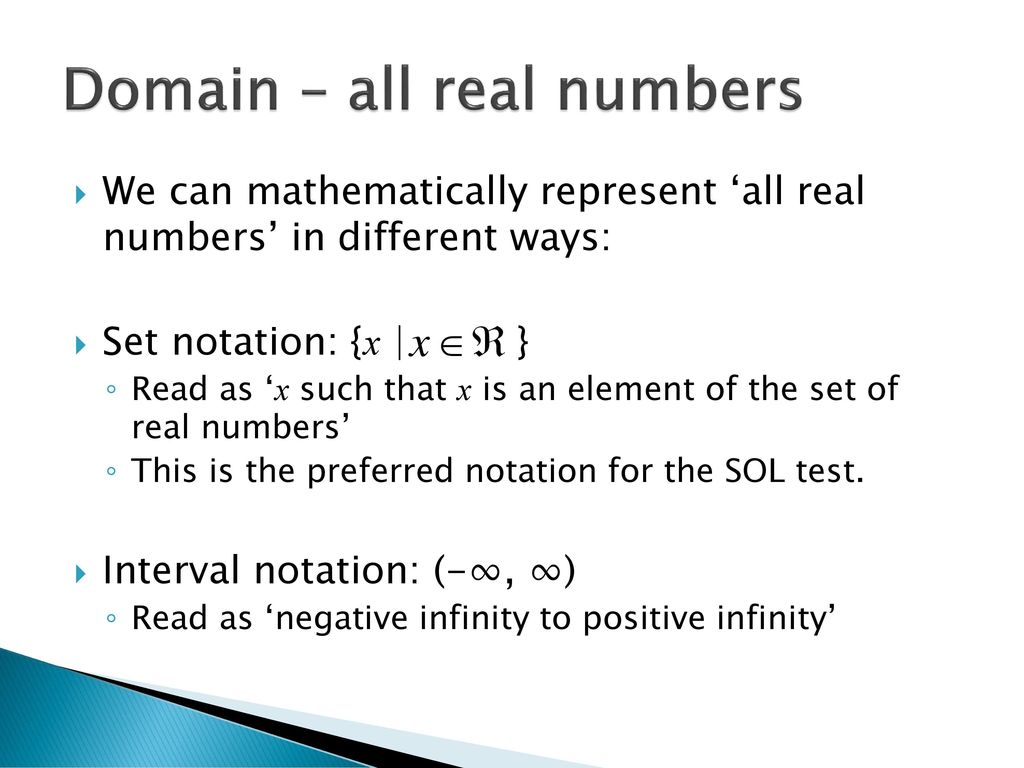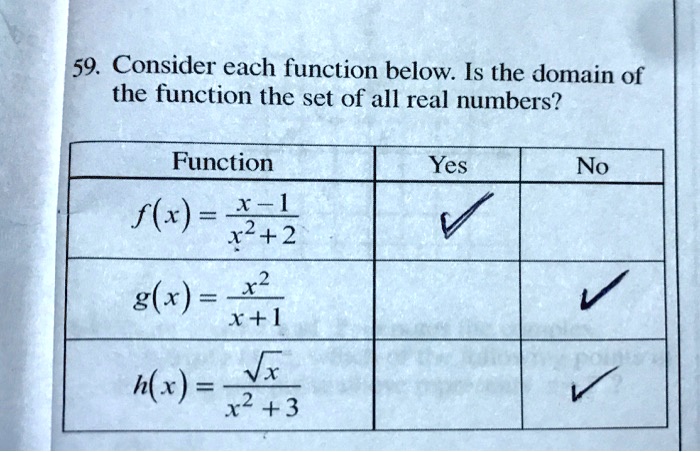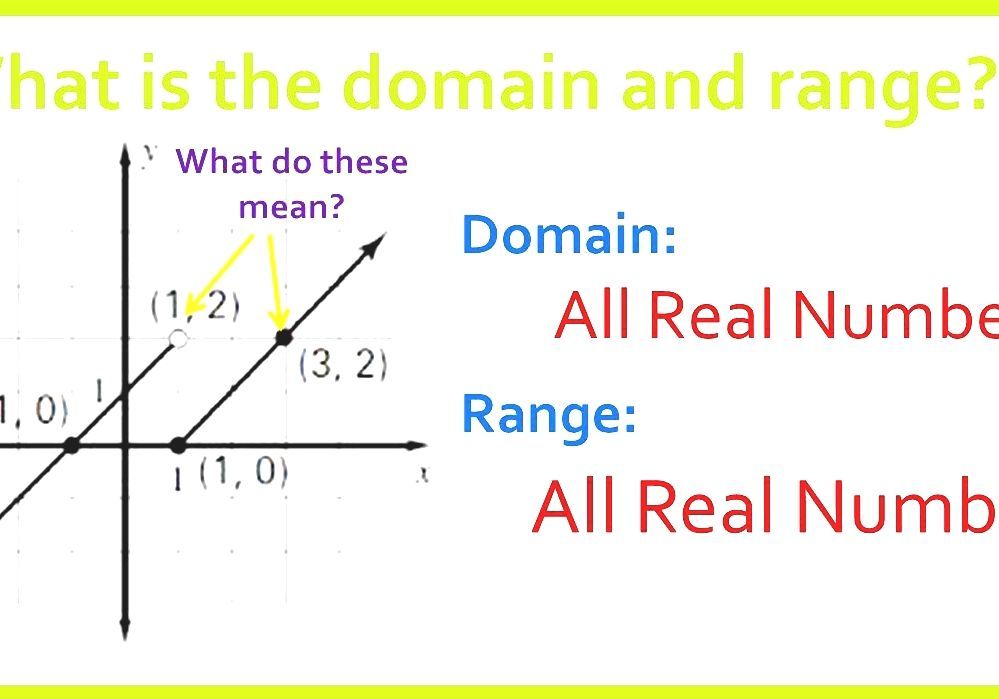Is Domain Always All Real Numbers

Imagine a vast, open field stretching as far as the eye can see. This field represents the realm of numbers, the real numbers. Now, picture drawing a line, a curve, or any kind of path across this field. Does this path always cover the entire field? The answer, surprisingly, is no. It's a bit like saying not every street in a city goes everywhere, and some are blocked off.
The question, "Is the domain always all real numbers?" is a fundamental one in mathematics. The short answer is no. While many mathematical functions happily accept any real number as input, others have restrictions, leading to domains that are smaller, more selective pieces of the vast real number landscape.
Let's explore why this is the case and what it means for how we understand and use mathematical functions. Understanding the domain of a function is crucial for its correct application in diverse fields like physics, engineering, and economics.
The Concept of Domain: A Foundation
At its heart, a function is like a machine: you feed it an input, and it spits out an output. The set of all possible inputs that the machine can handle without breaking down is its domain.
Think of a blender. You can blend fruits, vegetables, and liquids. But if you try to blend rocks, you might break the blender. The domain of a blender is limited to things it can actually process without damage.
In mathematical terms, the domain of a function is the set of all possible input values for which the function is defined and produces a real number output. It is the set of all x-values for which f(x) is a real number.
Why Isn't the Domain Always All Real Numbers?
There are several reasons why a function's domain might be restricted.
Division by Zero
One of the most common restrictions arises from the rule that you cannot divide by zero. If a function involves division, and the denominator can potentially be zero for some value of x, then that value must be excluded from the domain.
Consider the function f(x) = 1/x. If x were to equal 0, we would be dividing by zero, which is undefined. Therefore, the domain of this function is all real numbers except 0.
Square Roots of Negative Numbers
Another restriction arises from taking the square root of a negative number. In the realm of real numbers, the square root of a negative number is undefined.
The function g(x) = √x is only defined for non-negative values of x. Trying to take the square root of a negative number will result in an imaginary number, which falls outside the set of real numbers.
Logarithms of Non-Positive Numbers
Logarithmic functions have a similar restriction. Logarithms are only defined for positive numbers.
The function h(x) = log(x) is defined only when x is greater than 0. The logarithm of 0 or a negative number is undefined.
Real-World Constraints
Sometimes, the restrictions on the domain come from real-world constraints. Mathematical functions are often used to model real-world phenomena.
For example, if a function represents the height of a plant over time, the time cannot be negative. The domain would be restricted to non-negative values representing the timeframe of the plant's life.
Examples of Functions with Restricted Domains
Here are some more examples to illustrate how domains can be restricted:
- f(x) = √(x - 2): The domain is all x such that x ≥ 2 because the expression inside the square root must be non-negative.
- g(x) = 1/(x + 3): The domain is all x such that x ≠ -3 because the denominator cannot be zero.
- h(x) = log(5 - x): The domain is all x such that x < 5 because the argument of the logarithm must be positive.
Determining the Domain: A Practical Approach
To find the domain of a function, consider the potential restrictions:
- Are there any denominators? If so, set each denominator equal to zero and solve for x. These values must be excluded from the domain.
- Are there any square roots? If so, set the expression inside each square root greater than or equal to zero and solve for x. These values form part of the domain.
- Are there any logarithms? If so, set the expression inside each logarithm greater than zero and solve for x. These values form part of the domain.
- Consider any real-world constraints on the variables in the function.
The domain is the set of all real numbers that satisfy all these conditions.
The Significance of Understanding Domains
Understanding the domain of a function is crucial for several reasons:
- Correct Interpretation: Knowing the domain ensures that you're using the function in a way that makes sense mathematically and practically. Applying a function outside of its domain can lead to nonsensical or incorrect results.
- Accurate Modeling: When using functions to model real-world phenomena, understanding the domain helps ensure that the model accurately reflects the constraints of the situation.
- Graphical Representation: The domain defines the portion of the x-axis over which the graph of the function exists. Understanding the domain helps you interpret and sketch the graph accurately.
For example, in physics, if you're modeling the trajectory of a projectile, the domain of the function representing the height of the projectile will be limited by the time the projectile is in the air.
The Broader Implications
The concept of domain isn't just a mathematical technicality; it's a reflection of the limitations and possibilities inherent in the relationships we're trying to describe.
It teaches us that not everything is always possible or defined. It encourages us to consider the boundaries and constraints of the systems we study, whether those systems are mathematical or real-world.
By carefully considering the domain of a function, we can avoid pitfalls and gain a deeper understanding of the relationships between variables.
Conclusion: Appreciating the Boundaries
The question "Is the domain always all real numbers?" is answered resoundingly with a "no." The beauty of mathematics lies not just in the vastness of its landscape but also in the intricacies of its boundaries.
These boundaries, defined by restrictions like division by zero, square roots of negative numbers, and real-world constraints, shape the behavior and interpretation of functions. They remind us that even in the abstract world of mathematics, there are limits and possibilities that must be carefully considered.
By understanding and appreciating these boundaries, we can unlock a deeper understanding of the mathematical relationships that underpin our world. Just as a skilled artist understands the boundaries of their canvas, a mathematician understands the domain of their functions.







![Is Domain Always All Real Numbers [FREE] Which function has a domain of all real numbers - brainly.com](https://media.brainly.com/image/rs:fill/w:750/q:75/plain/https://us-static.z-dn.net/files/da0/f47a67a7becc00ab8122b059b8273ca2.png)




![Is Domain Always All Real Numbers [College Algebra: Domain and All Real Numbers] The question before this](https://i.redd.it/ag0ha2unukm71.png)





